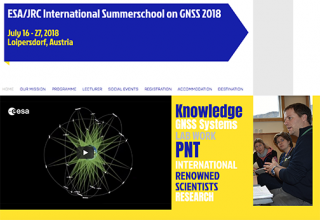 One of 12 magnetograms recorded at Greenwich Observatory during the Great Geomagnetic Storm of 1859
One of 12 magnetograms recorded at Greenwich Observatory during the Great Geomagnetic Storm of 1859 1996 soccer game in the Midwest, (Rick Dikeman image)
1996 soccer game in the Midwest, (Rick Dikeman image)
 Nouméa ground station after the flood
Nouméa ground station after the flood A pencil and a coffee cup show the size of NASA’s teeny tiny PhoneSat
A pencil and a coffee cup show the size of NASA’s teeny tiny PhoneSat Bonus Hotspot: Naro Tartaruga AUV
Bonus Hotspot: Naro Tartaruga AUV
 Pacific lamprey spawning (photo by Jeremy Monroe, Fresh Waters Illustrated)
Pacific lamprey spawning (photo by Jeremy Monroe, Fresh Waters Illustrated) “Return of the Bucentaurn to the Molo on Ascension Day”, by (Giovanni Antonio Canal) Canaletto
“Return of the Bucentaurn to the Molo on Ascension Day”, by (Giovanni Antonio Canal) Canaletto The U.S. Naval Observatory Alternate Master Clock at 2nd Space Operations Squadron, Schriever AFB in Colorado. This photo was taken in January, 2006 during the addition of a leap second. The USNO master clocks control GPS timing. They are accurate to within one second every 20 million years (Satellites are so picky! Humans, on the other hand, just want to know if we’re too late for lunch) USAF photo by A1C Jason Ridder.
The U.S. Naval Observatory Alternate Master Clock at 2nd Space Operations Squadron, Schriever AFB in Colorado. This photo was taken in January, 2006 during the addition of a leap second. The USNO master clocks control GPS timing. They are accurate to within one second every 20 million years (Satellites are so picky! Humans, on the other hand, just want to know if we’re too late for lunch) USAF photo by A1C Jason Ridder.  Detail of Compass/ BeiDou2 system diagram
Detail of Compass/ BeiDou2 system diagram Hotspot 6: Beluga A300 600ST
Hotspot 6: Beluga A300 600ST

1. EARTHQUAKE!
Seattle, Washington USA
√ Want to know where an earthquake will occur and how big it will be? The Pacific Northwest Geodetic Array (PANGA) geodesy lab can tell you. They use 350 continuously operating high-precision GPS receivers and can analyze and share quake data in less than a minute. (Fact: A megaquake is likely 50 miles from Seattle).
PANGA’s website
1. EARTHQUAKE!
Seattle, Washington USA
√ Want to know where an earthquake will occur and how big it will be? The Pacific Northwest Geodetic Array (PANGA) geodesy lab can tell you. They use 350 continuously operating high-precision GPS receivers and can analyze and share quake data in less than a minute. (Fact: A megaquake is likely 50 miles from Seattle).
PANGA’s website
2. TORTS
Park City, Utah USA
√ A young tourist asked Google Maps to plot a safe route during a nighttime walk around a Utah resort. The map guided her to a 4-lane highway, where she was hit by a car and sued Google for $100,000. No word if the driver was relying on his car’s navigation or crash-avoidance technologies at the time.
See the case here
3. 100% COMPLETE
Baikonur spaceport, Kazakhstan
√ Russia’s GLONASS constellation will be complete by the end of December 2010, said a JSC Russian Space Systems spokesman at the APEC/GIT meeting in Seattle in June. Three space vehicles are scheduled to launch from Baikonur on September 2, and another three at the end of December. Russia needs 24 satellites for global coverage.
4. PUMP FAILURE
Satish Dhawan Space Center (SHAR), India
√ Turbo-pump failure caused the April crash of India’s GSLV rocket and the loss of its GSAT-4 satellite that carried the country’s first GPS-Aided Geo Augmented Navigation (GAGAN) payload. On July 9, the Indian Space Research Organization (ISRO) said liquid hydrogen stopped flowing into the rocket’s thrust chamber right after ignition. No word on when, or on which launcher, GAGAN may fly again.
5. QZSS DELAY
Tanegashima Space Center, Japan
√ Japan’s space agency, JAXA, has postponed the August 2 launch of Michibiki, its first Quazi-Zenith Satellite, due to problems with the onboard reaction wheels. JAXA has decided to replace the parts. By 2013, QZSS’s planned three-satellite constellation will augment GPS over Japan, strengthening the signal in mountains and urban areas.
JAXA website





